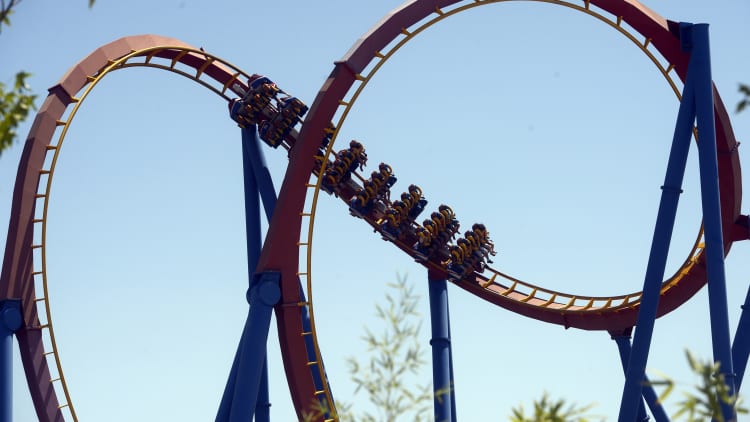
Every recent stock market decline has been a rallying cry to buy.
"Even when we saw the disruption in markets for Brexit and the election, the market was able to wash these events out of the matrix very quickly," said Dan Deming, managing director at KKM Financial. "Market participants are getting more and more conditioned to fade those moves."
The "buy the dip" trade is also one big reason market volatility is so low. Market pros aren't paying up to protect their flank as much as they have in the past.
The cost of "insurance" has gotten cheaper, as investors hedge against big moves with options in the . This is reflected in a low VIX — the market's so-called fear gauge — which is calculated based on those options. Right now, the VIX, or the CBOE Volatility Index, is flashing very low expectations for big swings in the S&P 500. In fact, its price, just under 10, implies a daily move of just two-thirds of a percent in either direction over the next 30 days.
Low volatility is showing up across financial markets — in stocks, bonds and currencies — though stocks have the lowest volatility of all, according to Ben Bowler, head of global equity derivatives research at Bank of America Merrill Lynch.
That will only change when herd behavior to "buy the dip" changes.
"The one thing that will really break us out of this funk is a shock in which the market initially buys the dip, and then you have a secondary shock that causes people to question whether this is the time when that trade breaks," Bowler said. "That will hit the reset button in terms of volatility."
Bowler said while the VIX only goes back to 1990, the realized volatility of the S&P would have been lower than it is now only 3 percent of the time going back to 1928. "It's very unusual statistically speaking. We've been setting records for volatility for quite some time," he said.
Some strategists say the low-volatility era can only end with a bang. Even Goldman Sachs CEO Lloyd Blankfein said it's a worry. He said the low-volatility markets may be reflecting a "bubble of confidence" and are not in a "normal resting state."
There are any number of back burner events that could trigger a jump in volatility, including an escalation of tensions with North Korea, or other geopolitical event. The potential for a slowdown in China is being watched carefully now, and there's political risk both in Europe and in the U.S, should Congress fail to adopt tax reform.

There are plenty of reasons behind the low volatility, such as the fact the stock market is near highs and interest rates are low. Washington promises pro-growth tax and spending policies. The Fed may be on track to raise interest rates, but it's not moving very quickly, and other central banks also have easy policies.
"Everybody likes to point to one favorite factor. It's a multitude of factors that are all coming together," said Bowler. "Most of the factors, I would argue, point back to a relatively sluggish growth environment where central banks still have a heavy hand in supporting markets overall. Some of these effects also have real feedback loops."
The eeriness of the calm in markets is striking after the initial flash of nervousness around the first round of the French election in April. Emmanuel Macron's victory on Sunday eased worries about a wave of far-right populism sweeping across Europe that would threaten the euro zone itself. That has driven stocks to highs, and volatility to lows.
Bowler says the phenomena of the quick spring-back in markets has been going on for the past two years. "This is an incredibly unusual environment, when you look at the behavior of markets, when shocks have no persistence. When any shock is bought and volatility fades," he said.
Markets on Wednesday shrugged off President Donald Trump's firing of FBI Director James Comey. It raised the hackles of Democrats and some Republican lawmakers. It could have also been a market calamity if it was perceived as having a detrimental impact on the economy or the promise of Trump policies that helped markets move higher.
"I believe in and of itself it's not viewed as an economic factor," said Deming. "It's more the same of Trump cleaning house when he sees fit. In theory, you would think it would knock people off, in terms of the stability factor of the government, but the market is getting conditioned to this is the way things are going to go in Washington."
Stocks were mixed in afternoon trading Wednesday, and the VIX moved slightly higher.
"[Investors] are not willing to pay up for insurance because of the more efficient market structure. We've seen the evolution of the volatility space. The options market participants are just not willing to pay a significant premium for that price of insurance. However, at some point it will reach a point where they are willing to pay," said Deming.
He said there are also aggressive sellers of volatility, driving the price lower. "The market's been able to maintain these new highs and grind higher with very little back-off. It's very difficult for options players to realize price momentum, and therefore we're just going to go lower," he said.
Deming said if there is an event that hurts dip buyers, they will quickly look for ways to hedge their exposure. "If we see a secondary leg down, that's typically when you get those volatility explosions, or a more significant reaction because dip buyers have been convinced over the last several years that buying the dip pays off, and it has," he said.
Watch: The volatility roadmap



